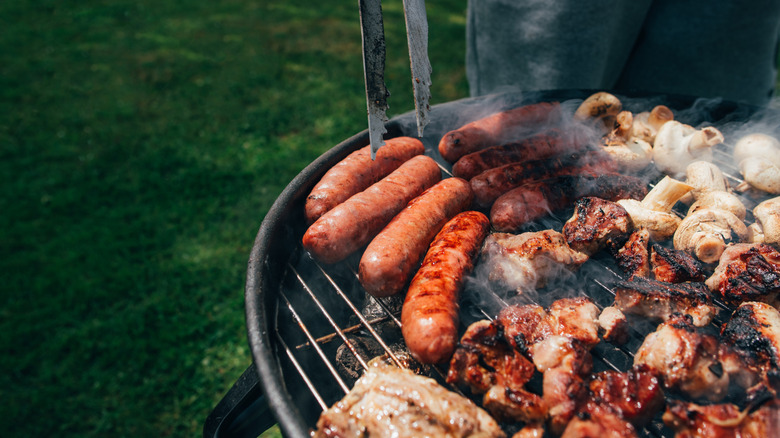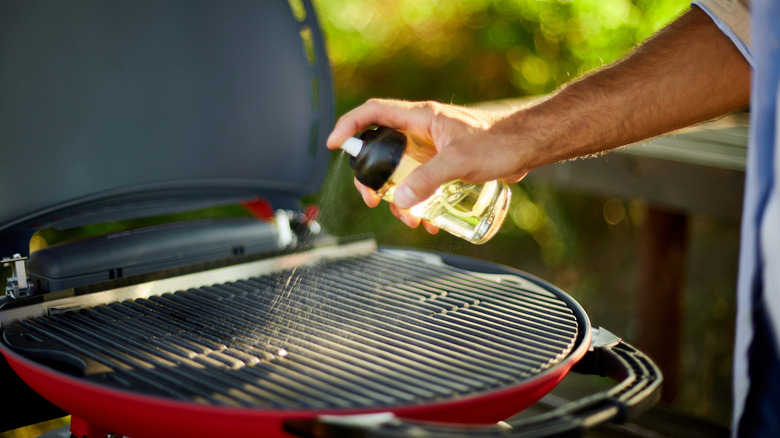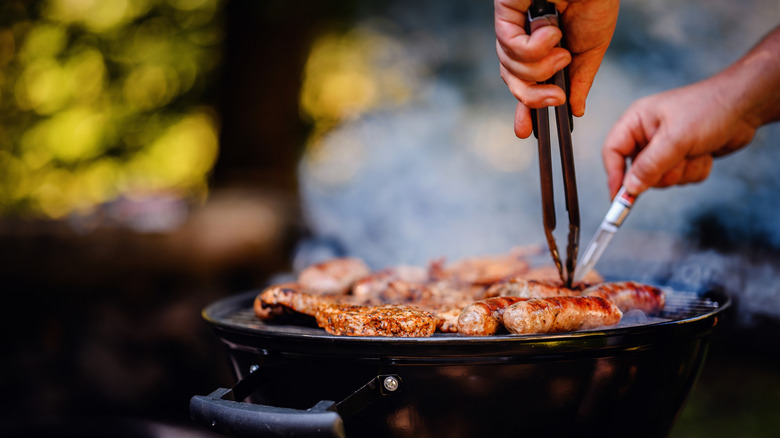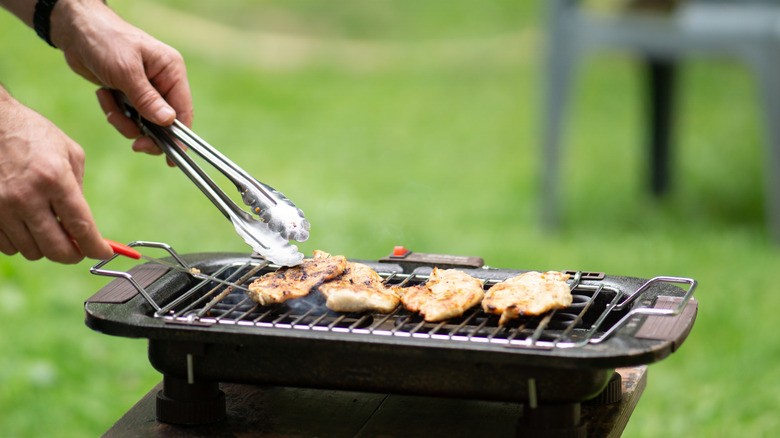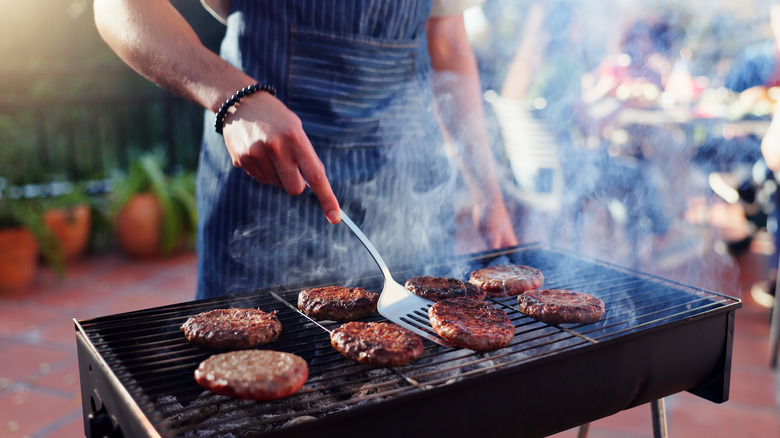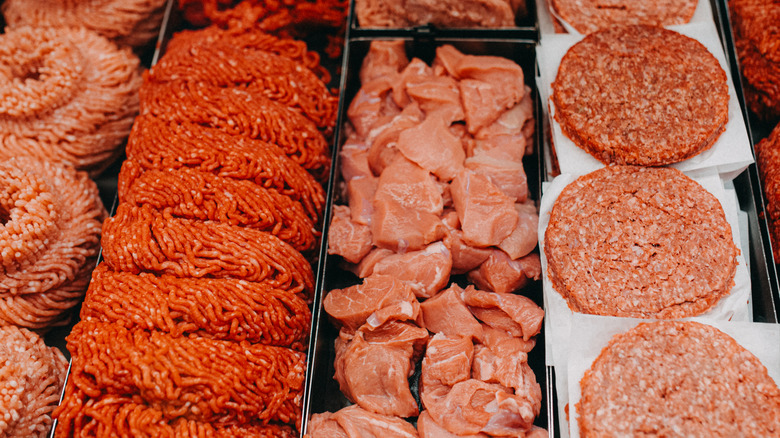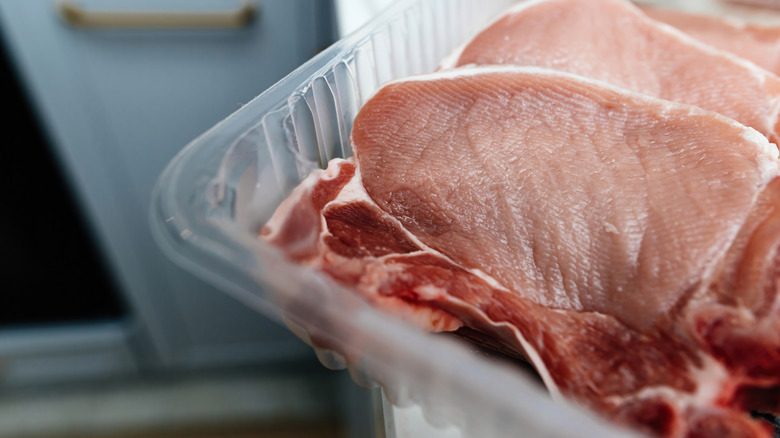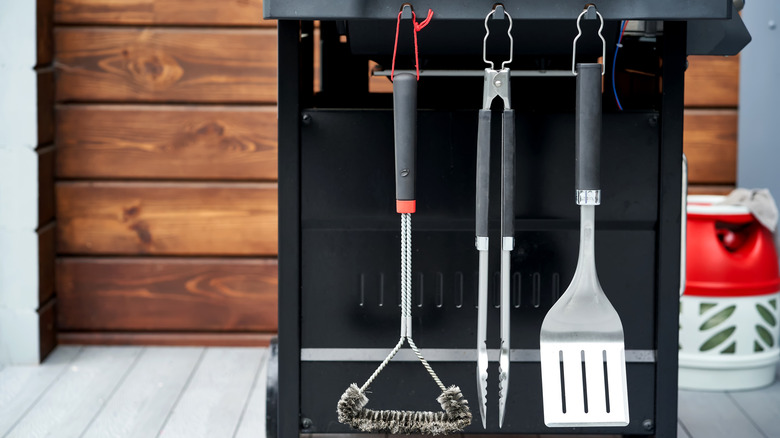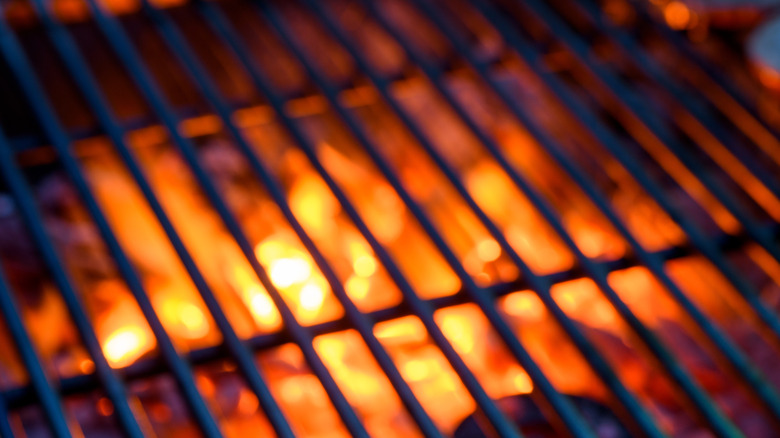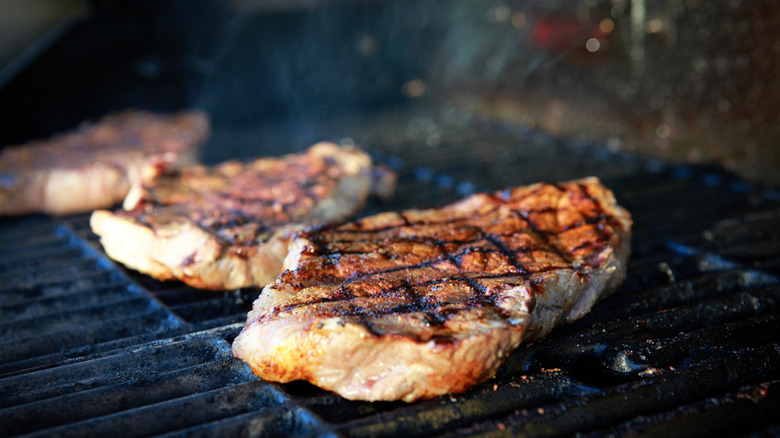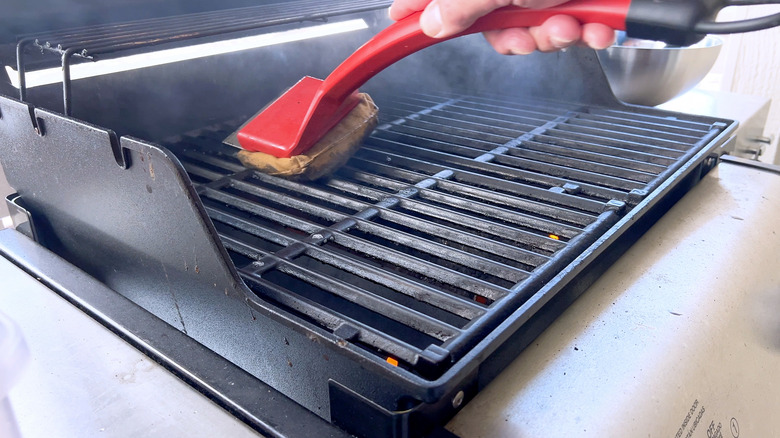10 Grill-Master Hacks For Flipping Meat On The Grill
Whether it's a simple cookout meal like burgers and hot dogs or a big, juicy steak, the flavor from a gas or charcoal grill is unmatched. Not only is the mouthwatering taste a big reason behind the craze, but firing up the grill is a seasonal rite of passage for many of us. While standing behind the grill chatting with friends looks like an easy task, there is some science behind getting those perfect charred marks on a delicious piece of meat.
This is especially true when it comes time to flip your meat for an even cook. It's a heartbreaker when that meat you've spent all day dreaming about sticks to the grates, leaving you with a less-than-perfect result. But not to worry, there are some techniques behind getting the perfect flip. We talked with grilling experts to find out some of the best hacks they have for flipping meat on the grill — if followed, they'll have your friends and family calling you the next big grillmaster.
1. Get your grill ready for cooking
The first trick to success starts before you even fire up the grill. Our experts say spending some extra time on preparation can be the difference between a sticky situation and smooth flipping. "A hot, clean, and well-seasoned grill is always the best way to start a grilling session," says Michael Senich, Corporate Executive Chef at LongHorn Steakhouse. "Scrape the hot grill and use a spray bottle with cooking oil to season the area before placing meat on the grill."
Just like when you are baking in an oven, you will want to add some time to your preparation process by preheating your grill before cooking. "People often forget to properly preheat their grill before adding meat," says Chef Scott Groth, founder of Easy Low Carb Recipes. "A hot grill not only sears the meat but also helps avoid sticking." The preheating process is a good time to season too, according to David "Chef Fig" Figueroa, President and Co-Founder of Melinda's Foods. "Don't forget to keep that grill grate clean and seasoned — apply a light coat of oil as it heats up to prevent any sticking disasters," he recommends.
2. Don't flip your meat too soon
You may be asking yourself how can you know when it's time to flip? Experts say trying to flip your meat before it's actually ready is one of the biggest grilling mistakes people make. "You want to let it sear and develop those nice grill marks," says Chef Fanila Nawaby, owner of Mimi's Kabob. "If the meat is sticking to the grill, that's a sign it's not ready yet." A little bit of patience can pay off. Scott Groth echoes the importance of the timing factor, saying that you should let the heat do its job of cooking your meat to perfection. "Let the grill work its magic and wait for the meat to release naturally before flipping," he recommends.
You also want to resist the urge to check your food while it is cooking, as it affects the sear. Stephen Chavez, senior chef-instructor at the Institute of Culinary Education's Los Angeles campus says he has found this to be the single biggest mistake people make. "Once the item is seared properly, it will pull away from the grill. But if you start peeking, the item will not be properly seared and will stick." he says.
3. Don't flip your meat too often
There is such a thing as causing too much commotion on the grill. Flipping your meat too often is another error made by even the more experienced cooks. "A common mistake is constantly checking on meat by flipping too frequently. This causes it to dry out and prevents a flavorful crust from forming," Arlo Harris of Grill Wizard Oz explains. In fact, depending on your food of choice and your grill's condition, flipping as little as once may be enough to cook your meat through. "There's no need to keep flipping your meat back and forth," says Fanila Nawaby. "This can cause it to dry out because each time you flip, juices escape. For the best results, flip your meat only once. This helps retain all the flavors and moisture, leaving you with a juicier bite."
While it may be a personal preference to flip your meat more often, experts say overdoing it with the spatula can impact the texture. "Some folks flip every minute, but that's not my style. I'm all about letting a nice crust develop before I flip," says Chef Fig. Flipping too often can also affect the overall cooking process of your food. "Constantly turning the meat prevents even cooking and can dry it out," notes Scott Groth. "The key is patience — usually, flipping once is enough for most cuts of meat."
4. Don't press down on the meat while cooking
It's a scene many of us have witnessed and may even be guilty of doing ourselves. It can be tempting to flatten burgers on the grill for timing purposes or just out of habit, but our experts say to step away from the spatula. "Pressing down on burgers or steaks might seem like a good way to speed things up, but it squeezes out all the delicious juices and leaves the meat dry," says Scott Groth.
Flattening your burgers against the grates also increases the likeliness the patties will stick, making flipping them all the more difficult. Instead of pressing down on burgers or steaks with a spatula, Fanila Nawaby suggests letting the meat do its thing. That way, you get to contain the flavorful juices and end up with a moist and delicious bite.
An exception to the no-flattening rule is when you are making a dish like smash burgers. These popular burgers are flattened or smashed in the first 30 seconds or so to give you a crisp patty that's still packed with flavor because the fat hasn't been rendered yet. Later in the cook is definitely not the time to flatten your patty, as that's when those juices and flavor can escape.
5. Adjust your grilling tactics for your meat type
Just like every protein has its differences, each grilling situation may require its own approach. Experts say you may need to adjust your technique depending on what meat you selected. "Steaks should be flipped every two to three minutes for an even crust, while burgers should only be flipped once to retain juices," says Arlo Harris. "Fish and delicate meats should be flipped carefully and less frequently to avoid breaking."
Depending on the meat, there is also a risk you could overcook it. "Letting a steak or other types of meats cook too long on one side will produce uneven cooking and could potentially overcook it," says Michael Senich. He also recommends placing the meat on a different part of the grate once you flip it. "This ensures the meat is coming in contact with a hot clean surface." And if you are on the quest for perfect diamond grill marks, Senich says to give your steak a quarter turn on each flip.
You also want to use some care when flipping delicate items and cook with minimal intervention. "Most beef, pork, and chicken are durable on the grill, but when grilling items such as flaky fish, they will become more delicate to handle as they cook. Thinner fish may only be able to be flipped once before being fully cooked," says Senich.
6. Be mindful of the meat's temperature before grilling
The starting temperature of the meat can make all the difference when it comes to sticking on the grate. "The secret to a perfect flip is all about meat temp! Cold meat sticks to the grill and falls apart on the flip, especially with fish and delicate cuts," says Chef Fig. "Let your meat come to room temperature, and you'll have way less sticking."
Using meat at room temperature is even more important for those thicker cuts like pork chops. This ensures even cooking all the way through at a faster pace, which can mean less time on the heat and less moisture lost. You also avoid overcooking, as you would with a cold steak or chicken right out of the fridge.
However, when you are tempering meat, you will want to be sure not to leave it out on the counter for too long. Around an hour should be sufficient, according to experts. If you leave it out any longer, you run the risk of getting into the "danger zone" (between 40 and 140 degrees Fahrenheit) where bacteria can start to develop. Increased bacteria means an increased risk of foodborne illnesses, and that is definitely a guest you don't want at your backyard barbecue!
7. Use the right grill tools
Tools are another factor when aiming for successful meat flipping. While grill kits may come with numerous accessories, experts say that tongs reign king. "I would suggest long tongs as a trick to flipping better. Don't use the clunky, big tongs that come in a grilling set. Get a good set of classic long tongs (16 inches) so you can flip carefully without the heat of the grill singeing your arm hair and causing you to flip carelessly because it is too hot for your arm over the hot grill," Stephen Chavez recommends, adding that you should also have a towel handy in case your tongs get too warm.
There is even a tool if you are cooking more delicate meat. "For delicate meats like fish or burgers, I recommend a fish spatula — something thin and flexible so you can get under it without turning it into a mess. Flip it once and call it a day!" says Chef Fig. And if you don't have a fish spatula, a wide spatula can work for burgers and fish, while long-handed tongs are best for steak or chops, according to Arlo Harris.
The biggest tool takeaway is that forks are a big faux pas for flipping, according to experts. "Forks can pierce the meat and let the juices run out, leaving it dry. Tongs allow you to flip the meat without causing damage or losing moisture," Fanila Nawaby explains.
8. Keep an even temperature on the grill
Keeping tabs on your grill temperature is a must. "The key is maintaining high, consistent heat and patience," says Arlo Harris, adding that keeping the lid closed the entire time can reduce heat and prevent the coveted sear marks. Monitoring the temperature can also be telling of when it's time to flip — and when your food is cooked evenly. "If the grill isn't hot enough, your meat could stick and potentially tear the surface of the meat apart. When the grill is hot, it makes it much easier to flip and turn the meat resulting in a better sear and even cooking," Michael Senich explains.
As for how hot it should be, it depends on what you're cooking and the meat's fat content. "Many grillers mistake using high heat for faster cooking. However, low and slow is often the way to go, especially for thicker cuts like steak or pork chops. This ensures the inside is cooked perfectly without burning the outside," says Scott Groth.
But some experts say the temperature of your meat is even more important than the grill temperature. "Honestly, it's less about the grill's heat and more about the meat's temperature. As long as your meat's at room temp and your grill is clean and oiled, you're golden," David Figueroa says. "I crank the heat high for a solid sear, but the flip itself won't be a problem as long as you've prepped your meat right."
9. Don't panic if your meat is stuck
It happens to the best of us — you follow all the right practices but still find your meat sticks. While you may think all hope is lost, resist the urge to force-flip it off the grates. "If your meat's stuck, don't panic and definitely don't force it!" says Chef Fig. "Let the Maillard effect do its thing. When it's ready, the meat will naturally release from the grill. Patience is key here — give it a bit more time before trying again."
The Maillard reaction is the chemical process that occurs when cooking meat at high temperatures (like on an open flame while barbecuing). The proteins and sugars on the outside of the meat combine to deepen the flavor. Not only can waiting for the Maillard reaction save your flipping situation, but it can make your food tastier, too.
But if you simply can't wait, you can carefully try to loosen the meat from the grates by oiling a wide spatula with a sharp edge and slowly lifting the edges of the meat. The oil can help release it and keep it from tearing off the surface layer. You should also reduce the heat during this process, and take some extra time to clean off the surface so you don't end up with a layer of food stuck to the meat.
10. Take care of your grill after cooking
Grilling requires a lot of preparation work. However, caring for your equipment after cooking can ensure your next session goes smoothly. Stephen Chavez says cleaning is a must and one of the basic rules of grilling. "Make sure that you follow the three rules of the grill: keep it hot, keep it clean, and keep it lubricated," he lists. "Make sure that you clean your grill before and after each time you use it."
Aside from the chance that you may forget if you delay the task, it can be easier to clean the grill when it is still warm. "Many think it's okay to leave the mess for later, but this can lead to the buildup of stubborn residues that are much harder to clean," Gabrielle Yap of Carnivore Style tells Mashed. This is especially important if you end up with some meat stuck on the grates despite your best efforts.
Furthermore, if you leave the residue on the surface, it may not reach the correct temperature. Temperature regulation issues can lead to possible fire flare-ups and inconsistent cooking. And, as experts note, maintaining a consistent temperature helps the process of flipping meat, while also ensuring an even cook. So it pays off to take the time to clean and scrape your grill with a good brush or flat edge scraper.
